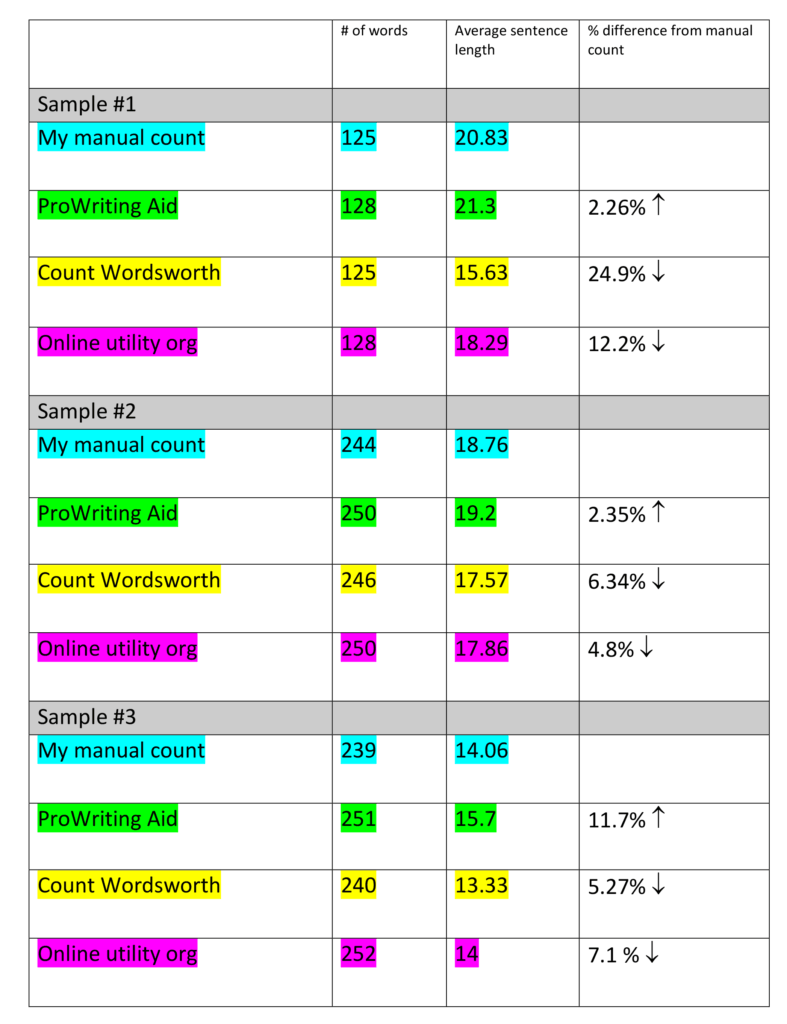Reading time: Just over 4 minutes
I received a distressing email from a client a few weeks ago. He had just run his latest article through an editing app I recommend, Count Wordsworth, and also through ProWritingAid, and Online-Utility.org, two other editing apps I favour. Troublingly, all the results were different.
So, what do these three apps do? Many tasks. They will count the number of words, identify clichés, calculate incidence of the verb “to be” and, in the case of ProWritingAid, mark grammatical errors. But the job for which I most value them is their ability to calculate average sentence length.
I use this metric ALL THE TIME, not just for my clients but also for my own writing. Why? Because I know if I can keep my average sentence length nice and low, my text will be more readable.
I like to focus on the average rather than the length of individual sentences. This is because, in English at least, too many short sentences in a row sound incredibly choppy. As well the juxtaposition of a relatively long sentence — say 32 words — followed by a very short one — say one to five words —sounds both graceful and elegant to the human ear. See what I mean? (In case you missed it, that was a 32-word sentence followed by a five-word one)
Interestingly, the ideal average number has changed over the decades. In 1893, English professor Lucius Adelno Sherman proposed the written word would be easier to understand if it matched the spoken word as closely as possible. In his day, that was 23 words.
Now, after decades of television and the Internet, experts such as Bob Elliot and Kevin Carroll, tell us the average should be somewhere between 14 and 18 words. Does that sound too short to you? You may or may not be a fan of author J.K. Rowling — but you won’t likely see her work as overly simplistic. Her average sentence length is 12.
Anyway, returning to my client’s problem, he told me that all three apps gave him completely different numbers for average sentence length. How was that possible, he asked, and which should he believe?
I didn’t know, but I was going to find out.
I spent several weeks trying to track down either owners or spokespeople for the various apps. I had no luck finding anyone associated with either Count Wordsworth or Online-Utility.org. But both of those apps are free and I can imagine the people who run them don’t have time to speak with people like me.
After engaging in some mild Twitter-based bullying, I eventually had an answer from the paid service ProWritingAid and what they told me blew me away. Every app counts words differently. You know the little number that appears at the bottom of your MS Word screen telling you how many words you wrote? Generating that number requires a number of assumptions. For example:
- Is a hyphenated word (e.g.: non-denominational) one word or two?
- Is a contraction (e.g.: don’t) one word or two?
- Is an acronym or initialism (e.g.: CIA or B.C.) one word or more?
- Is a sentence containing a semi-colon considered a single sentence or two?
The answers may be obvious to you, but your software may not agree with you. This fact — how each app calculates its word count — explains the differences between the three apps I’m writing about today.
When I heard this news, I threw up my hands and decided I needed to do a manual count of three random documents and chart the differences between my count and the results shown by the apps. The table below outlines these results:
As you can see if you consult the table, the apps can’t even agree on the basic length of each piece! (For the record, I counted hyphenated words, contractions, and acronyms as one word apiece. And I counted sentences with a semi-colon as a single sentence.) Overall, ProWritingAid tended to calculate a higher word count than my manual one, as did Online-utility.org. On the other hand, Count Wordsworth was generally closer to my count.
Overall, however, it’s clear that ProWritingAid tends to overestimate the average sentence length (based on my counting system) and Count Wordsworth and Online-Utility.org both underestimate it. Looking globally at the three samples I provided, ProWritingAid is off by 5.44%, Count Wordsworth by 12.15% and Online-Utility.org by 8.03%. To me, this makes ProWritingAid the winner but when I use their stats in the future, I’m going to remember that they tend to overestimate by just over five percent.
One more disclaimer: Keep in mind that I calculated these numbers for only three relatively short samples. To come to a more robust conclusion, I would have to do it for several hundred different pieces of writing. But I looked at my calendar and didn’t see a spare week…
You might ask why this information is important. Well, if you’re aiming to hit the 14-to-18 word average — a fairly tight range — you don’t want the software to be significantly “off.” Look at sample one, above. My count told me I was outside of the range at 20.8, but Count Wordsworth told me I was well inside it at 15.63. If I’d referred only to Count Wordsworth, I wouldn’t have tried to shorten any sentences. My piece, and my readers, would both have suffered.
So what am I going to do now (and recommend to my clients)? Rest assured I’m not going to start counting manually. That’s way too much work! Instead, I’m going to rely on ProWritingAid and understand that their estimates are often slightly “high.” So if they tell me my average sentence length is 19.5, I’m probably not going to worry about it.
ProWritingAid is a very detailed app that many people find confusing. But I think it’s perfectly okay to consult it for only what interests you. If you want to use it for calculating your sentence length average (and nothing else), enter your text into the box and then hit “summary.” Scroll down until you reach the “Sentence Structure” section (about three or four screensful down, depending on the size of your monitor) and look for the sentence length metric, which is presented in bright green.
Although I am a paid subscriber to ProWritingAid, I am not an affiliate so I will earn no money if you decide to subscribe. Further, it’s possible to use it online for fr/ee as long as you’re prepared to enter only 500 words at a time and do without a plagiarism checker.
*
If you want some help developing a writing routine, consider applying to my Get It Done program. Deadline for applying to this three-month accountability group (starting March 1) is this Friday, Feb. 22. To apply, go here and scroll down the very end and select the bright green “click here to apply now” button.
*
My video podcast last week described how to reduce your perfectionism. Or, see the transcript, and consider subscribing to my YouTube channel. If you have a question about writing you’d like me to address, be sure to send it to me by email, Twitter or Skype and I’ll try to answer it in the podcast.
*
Do you take the time to check your sentence length? How do you do it? We can all learn from each other so, please, share your thoughts with my readers and me in the “comments” section below. Anyone who comments on today’s post (or any others) by Feb. 28/19 will be put in a draw for a copy of the bestselling novel Asymmetry by Lisa Halliday. Please, scroll down to the comments, directly underneath the “related posts” links, below. Note that you don’t have to join the commenting software to post. See here to learn how to post as a guest.


